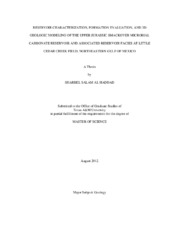| dc.description.abstract | Little Cedar Creek field is a mature oil field located in southeastern Conecuh County, Alabama, in the northeastern Gulf of Mexico. As of May 2012, 12.5 MMBLS of oil and 14.8 MMCF of natural gas have been produced from the field area. The main reservoirs are microbial carbonate facies and associated nearshore high energy shoal facies of the Upper Jurassic Smackover Formation that overlie conglomerate and sandstone facies of the Norphlet Formation and underlie the argillaceous, anhydritic-carbonaceous facies of the Haynesville Formation. These carbonate reservoirs are composed of vuggy boundstone and moldic grainstone, and the petroleum trap is stratigraphic being controlled primarily by changes in depositional facies. To maximize recovery and investment in the field, an integrated geoscientific-engineering reservoir-wide development plan is needed, including reservoir characterization, modeling, and simulation. This research presents a workflow for geological characterization, formation evaluation, and 3D geologic modeling for fields producing from microbial carbonates and associated reservoirs. The workflow is used to develop a 3D geologic model for the carbonate reservoirs. Step I involves core description and thin section analysis to divide and characterize the different Smackover facies in the field area into 7 units. The main reservoir facies are the microbial boundstone characterized by vuggy porosity and nearshore/shoal grainstone characterized by moldic porosity. Step II is well log correlation and formation evaluation of 113 wells. We use wireline logs and conventional core data analysis data to calculate average porosity values, permeability and water saturations. Neural networks are utilized at this stage to derive permeability where core measurements are absent or partially present across the reservoirs. Step III is building the 3D structural and stratigraphic framework that is populated with the petrophysical parameters calculated in the previous step. Overall, the integration of reservoir characterization, formation evaluation, and 3D geologic modeling provides a sound framework in the establishment of a field/reservoir-wide development plan for optimal primary and enhanced recovery for these Upper Jurassic microbial carbonate and associated reservoirs. Such a reservoir-wide development plan has broad application to other fields producing from microbial carbonate reservoirs. | en |


